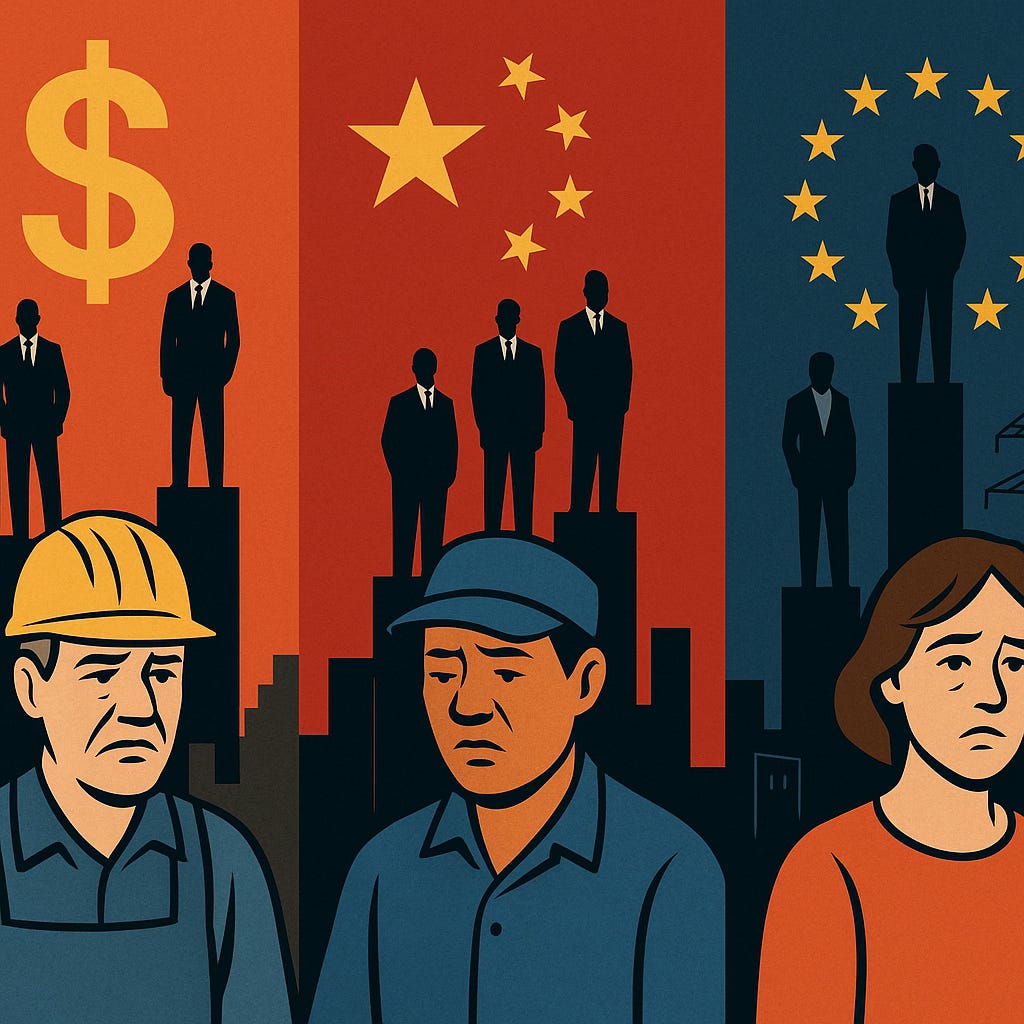Wealth inequality is rising globally, but the past decade’s drift toward more centralized or authoritarian politics has redefined how it grows—and who accrues most of its gains. In the U.S., China, and the European Union, wealth and power are interwoven within unique political structures. This piece examines how that coalescence shapes economic outcomes—and the prospects for ordinary people.
United States: Corporate Power + Weakening Democratic Norms
Trend: Amid political polarization and weakened institutions, elite influence through lobbying and billionaire wealth has flourished.
Wealth Effects:
The top 1% now control more than half of the stock and mutual fund wealth. Most of the bottom 90%’s wealth remains tied up in homes, assets hit hardest by crises. (Inequality.org)
During the pandemic, billionaires’ wealth surged by an estimated 70%, reversing decades of marginal decline. (Wikipedia)
The Wall Street Journal reports the top 10% of earners now command nearly 50% of total consumer spending—up from 36% in 1989. (WSJ)
Oxfam notes America’s 10 wealthiest individuals gained about $1B/day last year. (Daily Beast)
Outlook: Inequality is increasingly political, insulating elites from accountability. Policies cutting supports while preserving tax benefits risk deepening the rift.
China: State-Capitalism and Controlled Redistribution
Trend: Xi Jinping’s power consolidation reshaped economic elites through “common prosperity” campaigns, tech crackdowns, and property market discipline.
Wealth Effects:
Crackdowns on tech moguls realigned wealth to politically aligned, state-protected elites. (Fortune)
The Evergrande collapse and broader property market crisis wiped out consumer trust and suppressed household wealth, especially among urban families. (FT, Wikipedia)
Redistributive rhetoric disguised structural control—mobility is allowed only within tightly regulated bounds. (Taylor & Francis)
Outlook: The state’s management of inequality preserves order but restricts upward mobility—particularly for younger urban generations navigating property shocks and surveillance pressure.
European Union: Technocracy, Crisis, and Divergence
Trend: While member states like Hungary and Poland veer illiberal, Brussels leans technocratic—emphasizing policy over politics.
Wealth Effects:
Wealth disparities mirror North–South lines: northern economies far outpace debt-laden southern ones. (WSJ)
Energy price shocks after the war in Ukraine hit low-income households hardest, worsening inequality. (MDPI)
Demographic shifts strain southern and eastern EU welfare systems, increasing pressure on healthcare and pensions. (Bruegel)
Outlook: Brussels could use green and tech policy to correct imbalances. But if regulations fail to deliver tangible benefits, technocracy risks fueling populist backlash.
Shared Dynamics: A Triadic Breakdown
Despite their differences, the U.S., China, and the EU share common patterns:
United States
Protectors of inequality: financial and corporate elites
Citizens affected by: asset bubbles, housing strain, broken public services
China
Protectors of inequality: state-affiliated oligarchy
Citizens affected by: wealth shocks, surveillance, constrained mobility
European Union
Protectors of inequality: technocratic institutions and welfare bureaucracies
Citizens affected by: energy bills, demographic decline, low investment
Across all three, elites are shielded—whether by lobbying, party ties, or technocratic insulation—while citizens shoulder increasingly fragile lives: precarious work, unaffordable housing, and weakened social safety nets.
Looking Ahead: The Next Decade
U.S.: Unless political reform intervenes, entrenched plutocracy may make inequality irreversible—compressing the middle class.
China: Managed stability may continue, but opportunities for social advancement shrink under data-driven control and property decline.
EU: Regulation could rebalance wealth—but uneven enforcement or distant technocracy risks populist revolt if citizen trust erodes.
Wealth inequality is not a natural force but a product of political-economic systems. In each region, different actors—corporations, party elites, technocrats—have aligned to protect their interests. The crucial question of the next decade: Will citizens reclaim voice, or be pushed further aside by “elites first” governance?
